International Trade and Enterprise
VerifiedAdded on 2023/01/06
|11
|3876
|83
AI Summary
This assignment covers various topics such as world trade overview and Gravity model, resources and trade, Heckscher Ohlin Model. Economies of scale, imperfect competition, international trade, international factor movement’s etc. are discussed in this report.
Contribute Materials
Your contribution can guide someone’s learning journey. Share your
documents today.
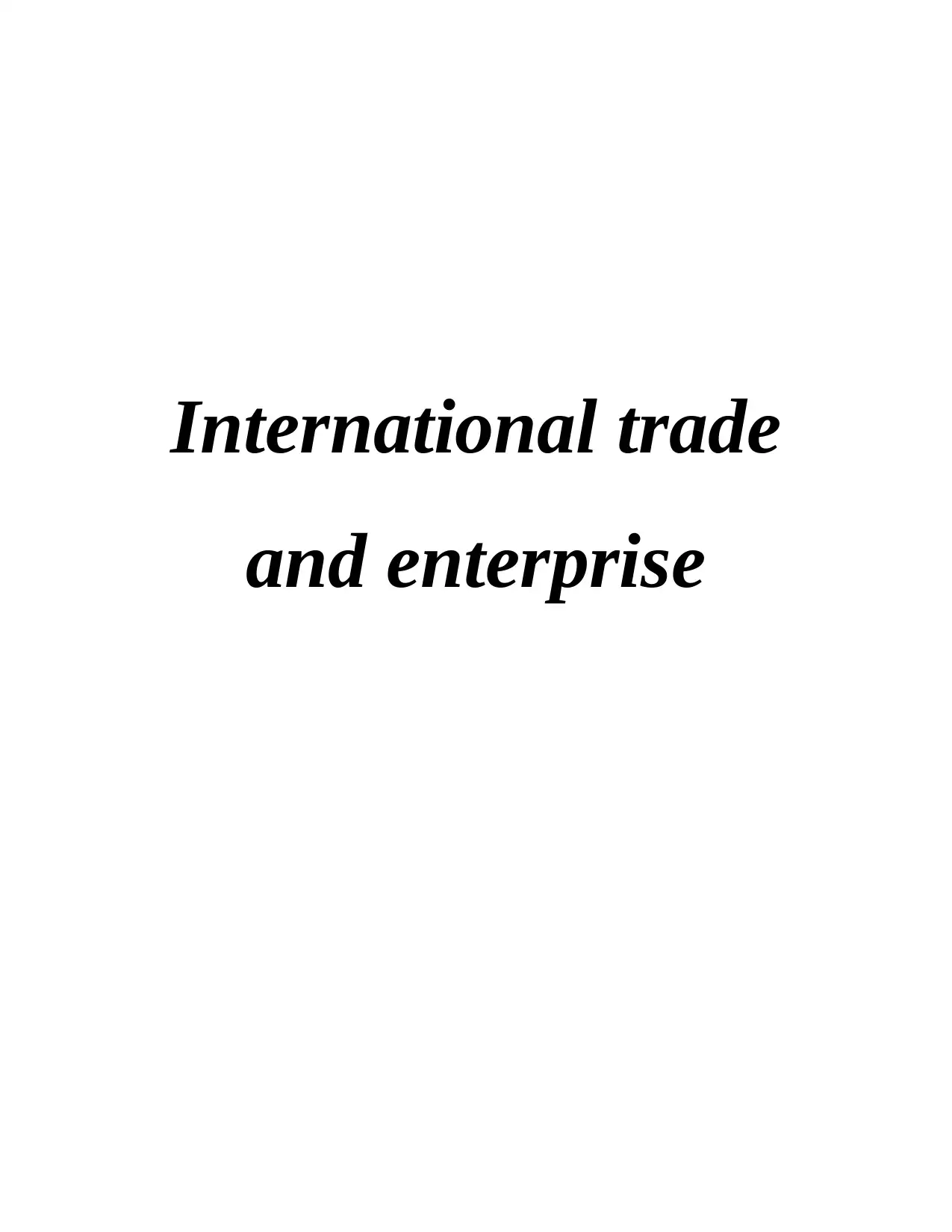
International trade
and enterprise
and enterprise
Secure Best Marks with AI Grader
Need help grading? Try our AI Grader for instant feedback on your assignments.

INTRODUCTION...........................................................................................................................1
MAIN BODY..................................................................................................................................1
QUESTION 1..................................................................................................................................1
Examination of the causes of the British Changing trade patterns with reference to Gravity
Model...........................................................................................................................................1
QUESTION 2..................................................................................................................................3
The way in which Ricardian Model different from the H-O theory in explaining the
international trade patterns among nations..................................................................................3
QUESTION 3..................................................................................................................................4
Discussion of trade need not be the result of comparative advantage but it can be a result of
economies of scale.......................................................................................................................4
QUESTION 4..................................................................................................................................5
Explain the effects of migration of labour between two nations.................................................5
QUESTION 5..................................................................................................................................6
Infant Industry protection is a key solution for the growth of industrialization of developing
countries.......................................................................................................................................6
QUESTION 6..................................................................................................................................7
Anti-globalisation movement goals and was it right or not.........................................................7
CONCLUSION................................................................................................................................8
REFENRECES................................................................................................................................9
MAIN BODY..................................................................................................................................1
QUESTION 1..................................................................................................................................1
Examination of the causes of the British Changing trade patterns with reference to Gravity
Model...........................................................................................................................................1
QUESTION 2..................................................................................................................................3
The way in which Ricardian Model different from the H-O theory in explaining the
international trade patterns among nations..................................................................................3
QUESTION 3..................................................................................................................................4
Discussion of trade need not be the result of comparative advantage but it can be a result of
economies of scale.......................................................................................................................4
QUESTION 4..................................................................................................................................5
Explain the effects of migration of labour between two nations.................................................5
QUESTION 5..................................................................................................................................6
Infant Industry protection is a key solution for the growth of industrialization of developing
countries.......................................................................................................................................6
QUESTION 6..................................................................................................................................7
Anti-globalisation movement goals and was it right or not.........................................................7
CONCLUSION................................................................................................................................8
REFENRECES................................................................................................................................9

INTRODUCTION
International trade could be defined as the exchange if goods, services and capital across
the international market. With the help of it, all the organisations can carry out all the operations
in different nations and generate higher revenues (Baier and Bergstrand, 2019). In different
countries it represents a significant sharing of GDP. There are various types of trades such as
export, import, entrepot etc. It is a type of combination of import and export trade which is called
re-export. It is very beneficial for all the countries that are conducting international trade. These
are increased revenues disposal of surplus goods, better risk management, longer product
lifespan, benefiting from currency exchange etc. Present report is based upon assessment of
various aspects in context of international trade. This assignment covers various topics such as
world trade overview and Gravity model, resources and trade, Heckscher Ohlin Model.
Economies of scale, imperfect competition, international trade, international factor movement’s
etc. are discussed in this report. Apart from this, trade policy in newly industrialized and
Controversies in Trade policy are also covered in this assignment.
MAIN BODY
QUESTION 1
Examination of the causes of the British Changing trade patterns with reference to Gravity
Model
During the 19th Century Britain was performing trade activities with nations from various
places around the world. It includes Asia, Africa, North and Latin America and most of it was
done with European Countries. There are various causes of Britain changing the trade patterns. It
could be understood with the help of Gravity Model. It is model of international trade which is
applied in the international economies. In traditional form it was used for the purpose of
predicting bilateral trade flows which are based upon economic sizes and it is also used to
analyse distance between two of the units. This model described that interrelation among two
different locations could be analysed by the items of the individuals of the places which could be
divided by the square of the distance from one to another. One of the main implications of this
model is that the distance in not the single element or factor which can help to determine the
interaction between two different countries or cities. In 19th Century Britain was importing and
exporting its goods in different location but with the time the trading patterns of it was changes
1
International trade could be defined as the exchange if goods, services and capital across
the international market. With the help of it, all the organisations can carry out all the operations
in different nations and generate higher revenues (Baier and Bergstrand, 2019). In different
countries it represents a significant sharing of GDP. There are various types of trades such as
export, import, entrepot etc. It is a type of combination of import and export trade which is called
re-export. It is very beneficial for all the countries that are conducting international trade. These
are increased revenues disposal of surplus goods, better risk management, longer product
lifespan, benefiting from currency exchange etc. Present report is based upon assessment of
various aspects in context of international trade. This assignment covers various topics such as
world trade overview and Gravity model, resources and trade, Heckscher Ohlin Model.
Economies of scale, imperfect competition, international trade, international factor movement’s
etc. are discussed in this report. Apart from this, trade policy in newly industrialized and
Controversies in Trade policy are also covered in this assignment.
MAIN BODY
QUESTION 1
Examination of the causes of the British Changing trade patterns with reference to Gravity
Model
During the 19th Century Britain was performing trade activities with nations from various
places around the world. It includes Asia, Africa, North and Latin America and most of it was
done with European Countries. There are various causes of Britain changing the trade patterns. It
could be understood with the help of Gravity Model. It is model of international trade which is
applied in the international economies. In traditional form it was used for the purpose of
predicting bilateral trade flows which are based upon economic sizes and it is also used to
analyse distance between two of the units. This model described that interrelation among two
different locations could be analysed by the items of the individuals of the places which could be
divided by the square of the distance from one to another. One of the main implications of this
model is that the distance in not the single element or factor which can help to determine the
interaction between two different countries or cities. In 19th Century Britain was importing and
exporting its goods in different location but with the time the trading patterns of it was changes
1
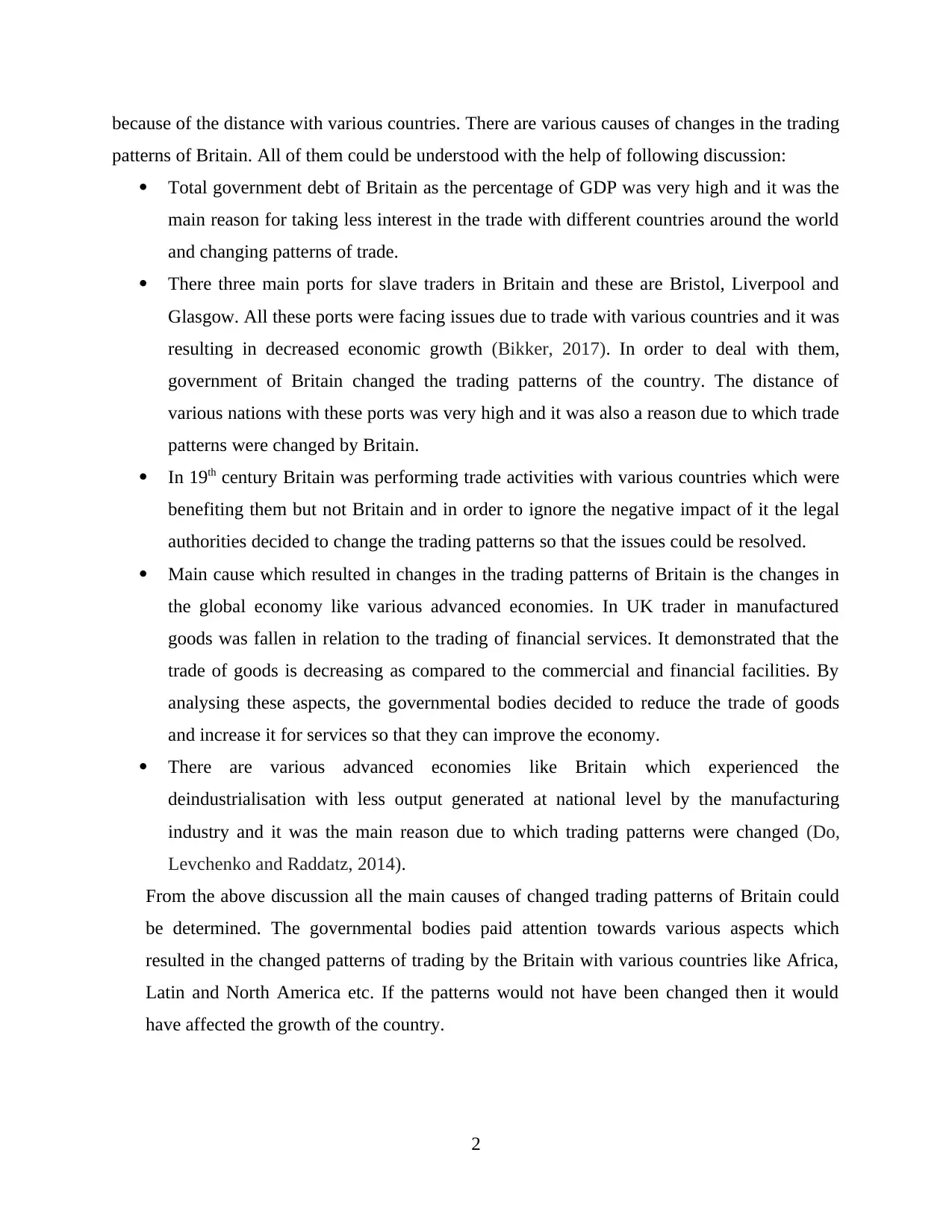
because of the distance with various countries. There are various causes of changes in the trading
patterns of Britain. All of them could be understood with the help of following discussion:
Total government debt of Britain as the percentage of GDP was very high and it was the
main reason for taking less interest in the trade with different countries around the world
and changing patterns of trade.
There three main ports for slave traders in Britain and these are Bristol, Liverpool and
Glasgow. All these ports were facing issues due to trade with various countries and it was
resulting in decreased economic growth (Bikker, 2017). In order to deal with them,
government of Britain changed the trading patterns of the country. The distance of
various nations with these ports was very high and it was also a reason due to which trade
patterns were changed by Britain.
In 19th century Britain was performing trade activities with various countries which were
benefiting them but not Britain and in order to ignore the negative impact of it the legal
authorities decided to change the trading patterns so that the issues could be resolved.
Main cause which resulted in changes in the trading patterns of Britain is the changes in
the global economy like various advanced economies. In UK trader in manufactured
goods was fallen in relation to the trading of financial services. It demonstrated that the
trade of goods is decreasing as compared to the commercial and financial facilities. By
analysing these aspects, the governmental bodies decided to reduce the trade of goods
and increase it for services so that they can improve the economy.
There are various advanced economies like Britain which experienced the
deindustrialisation with less output generated at national level by the manufacturing
industry and it was the main reason due to which trading patterns were changed (Do,
Levchenko and Raddatz, 2014).
From the above discussion all the main causes of changed trading patterns of Britain could
be determined. The governmental bodies paid attention towards various aspects which
resulted in the changed patterns of trading by the Britain with various countries like Africa,
Latin and North America etc. If the patterns would not have been changed then it would
have affected the growth of the country.
2
patterns of Britain. All of them could be understood with the help of following discussion:
Total government debt of Britain as the percentage of GDP was very high and it was the
main reason for taking less interest in the trade with different countries around the world
and changing patterns of trade.
There three main ports for slave traders in Britain and these are Bristol, Liverpool and
Glasgow. All these ports were facing issues due to trade with various countries and it was
resulting in decreased economic growth (Bikker, 2017). In order to deal with them,
government of Britain changed the trading patterns of the country. The distance of
various nations with these ports was very high and it was also a reason due to which trade
patterns were changed by Britain.
In 19th century Britain was performing trade activities with various countries which were
benefiting them but not Britain and in order to ignore the negative impact of it the legal
authorities decided to change the trading patterns so that the issues could be resolved.
Main cause which resulted in changes in the trading patterns of Britain is the changes in
the global economy like various advanced economies. In UK trader in manufactured
goods was fallen in relation to the trading of financial services. It demonstrated that the
trade of goods is decreasing as compared to the commercial and financial facilities. By
analysing these aspects, the governmental bodies decided to reduce the trade of goods
and increase it for services so that they can improve the economy.
There are various advanced economies like Britain which experienced the
deindustrialisation with less output generated at national level by the manufacturing
industry and it was the main reason due to which trading patterns were changed (Do,
Levchenko and Raddatz, 2014).
From the above discussion all the main causes of changed trading patterns of Britain could
be determined. The governmental bodies paid attention towards various aspects which
resulted in the changed patterns of trading by the Britain with various countries like Africa,
Latin and North America etc. If the patterns would not have been changed then it would
have affected the growth of the country.
2
Paraphrase This Document
Need a fresh take? Get an instant paraphrase of this document with our AI Paraphraser
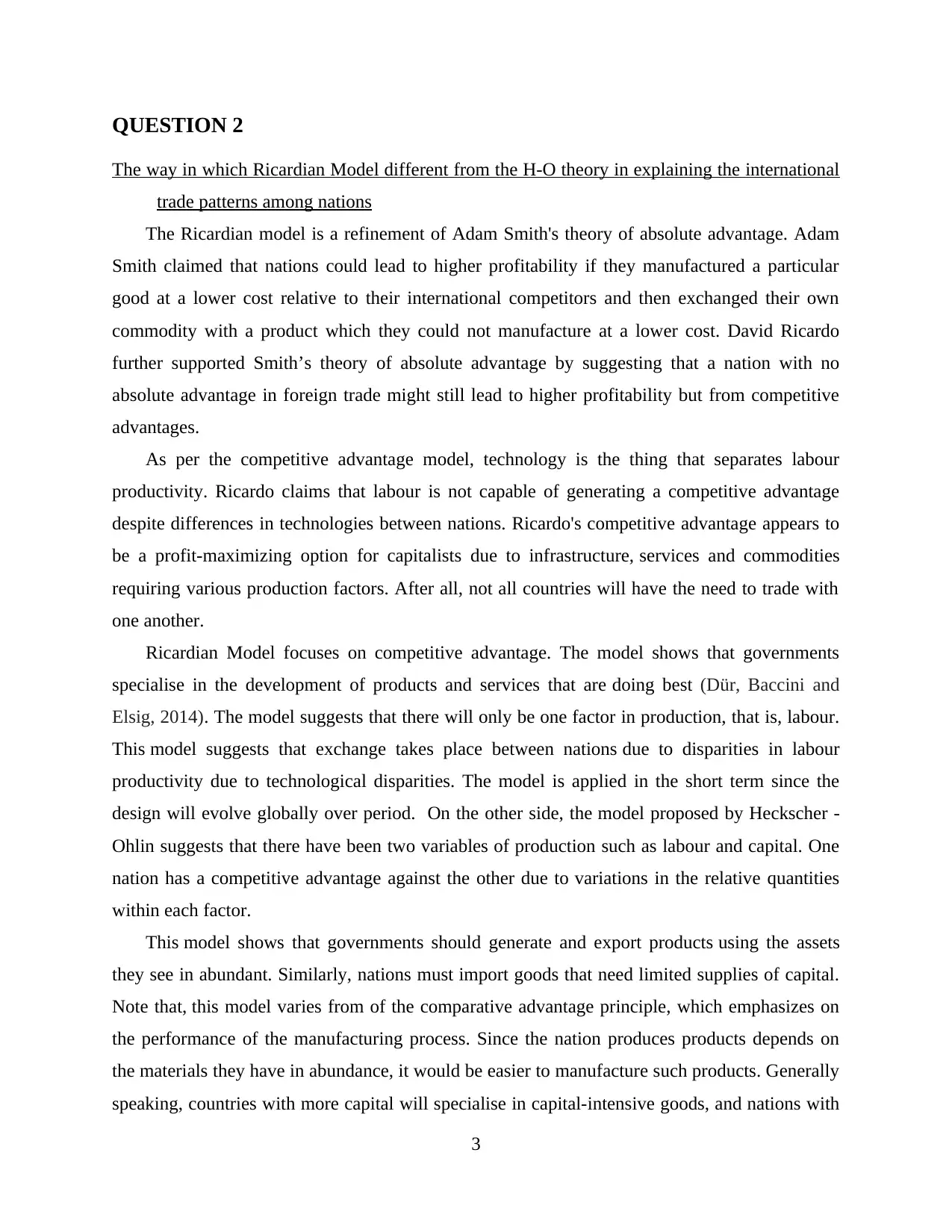
QUESTION 2
The way in which Ricardian Model different from the H-O theory in explaining the international
trade patterns among nations
The Ricardian model is a refinement of Adam Smith's theory of absolute advantage. Adam
Smith claimed that nations could lead to higher profitability if they manufactured a particular
good at a lower cost relative to their international competitors and then exchanged their own
commodity with a product which they could not manufacture at a lower cost. David Ricardo
further supported Smith’s theory of absolute advantage by suggesting that a nation with no
absolute advantage in foreign trade might still lead to higher profitability but from competitive
advantages.
As per the competitive advantage model, technology is the thing that separates labour
productivity. Ricardo claims that labour is not capable of generating a competitive advantage
despite differences in technologies between nations. Ricardo's competitive advantage appears to
be a profit-maximizing option for capitalists due to infrastructure, services and commodities
requiring various production factors. After all, not all countries will have the need to trade with
one another.
Ricardian Model focuses on competitive advantage. The model shows that governments
specialise in the development of products and services that are doing best (Dür, Baccini and
Elsig, 2014). The model suggests that there will only be one factor in production, that is, labour.
This model suggests that exchange takes place between nations due to disparities in labour
productivity due to technological disparities. The model is applied in the short term since the
design will evolve globally over period. On the other side, the model proposed by Heckscher -
Ohlin suggests that there have been two variables of production such as labour and capital. One
nation has a competitive advantage against the other due to variations in the relative quantities
within each factor.
This model shows that governments should generate and export products using the assets
they see in abundant. Similarly, nations must import goods that need limited supplies of capital.
Note that, this model varies from of the comparative advantage principle, which emphasizes on
the performance of the manufacturing process. Since the nation produces products depends on
the materials they have in abundance, it would be easier to manufacture such products. Generally
speaking, countries with more capital will specialise in capital-intensive goods, and nations with
3
The way in which Ricardian Model different from the H-O theory in explaining the international
trade patterns among nations
The Ricardian model is a refinement of Adam Smith's theory of absolute advantage. Adam
Smith claimed that nations could lead to higher profitability if they manufactured a particular
good at a lower cost relative to their international competitors and then exchanged their own
commodity with a product which they could not manufacture at a lower cost. David Ricardo
further supported Smith’s theory of absolute advantage by suggesting that a nation with no
absolute advantage in foreign trade might still lead to higher profitability but from competitive
advantages.
As per the competitive advantage model, technology is the thing that separates labour
productivity. Ricardo claims that labour is not capable of generating a competitive advantage
despite differences in technologies between nations. Ricardo's competitive advantage appears to
be a profit-maximizing option for capitalists due to infrastructure, services and commodities
requiring various production factors. After all, not all countries will have the need to trade with
one another.
Ricardian Model focuses on competitive advantage. The model shows that governments
specialise in the development of products and services that are doing best (Dür, Baccini and
Elsig, 2014). The model suggests that there will only be one factor in production, that is, labour.
This model suggests that exchange takes place between nations due to disparities in labour
productivity due to technological disparities. The model is applied in the short term since the
design will evolve globally over period. On the other side, the model proposed by Heckscher -
Ohlin suggests that there have been two variables of production such as labour and capital. One
nation has a competitive advantage against the other due to variations in the relative quantities
within each factor.
This model shows that governments should generate and export products using the assets
they see in abundant. Similarly, nations must import goods that need limited supplies of capital.
Note that, this model varies from of the comparative advantage principle, which emphasizes on
the performance of the manufacturing process. Since the nation produces products depends on
the materials they have in abundance, it would be easier to manufacture such products. Generally
speaking, countries with more capital will specialise in capital-intensive goods, and nations with
3
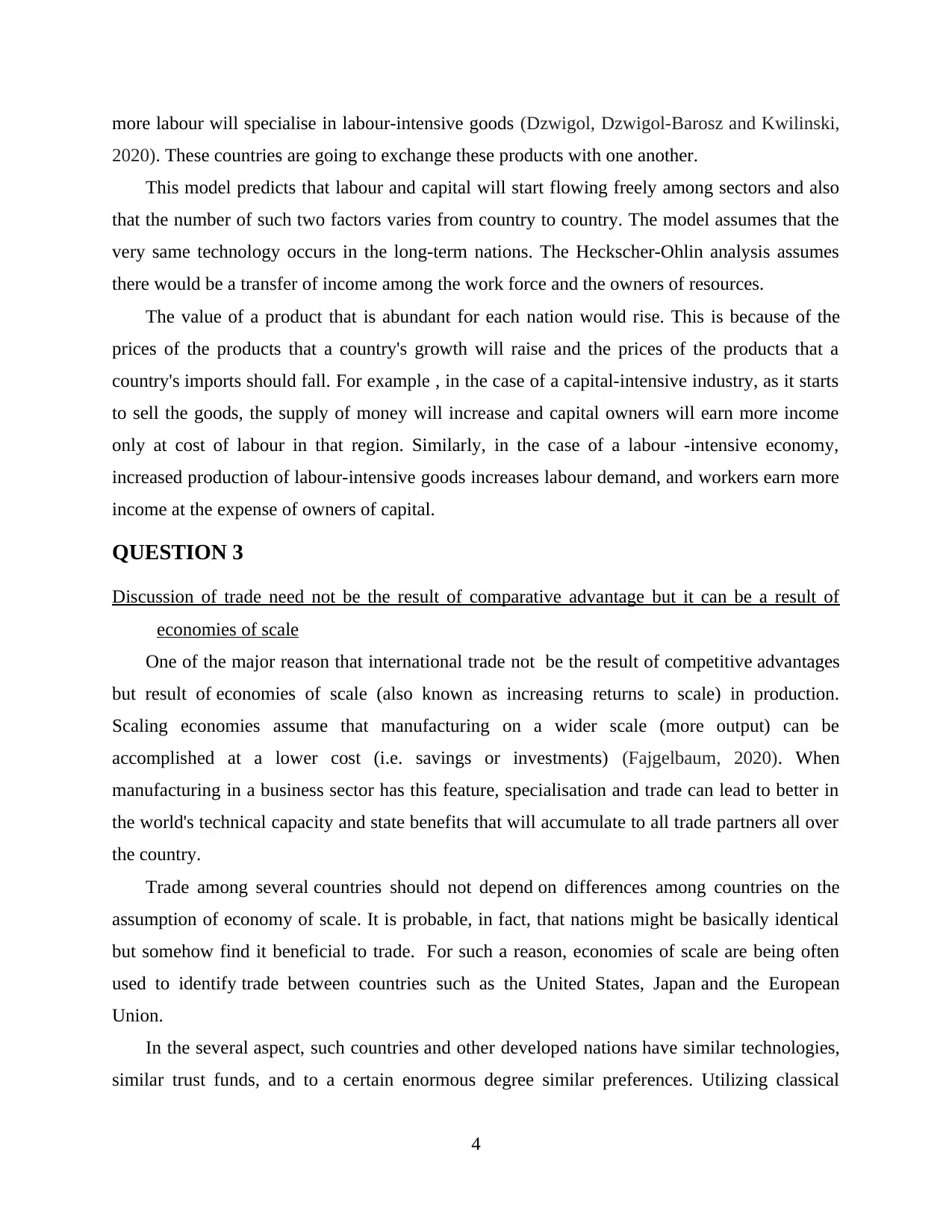
more labour will specialise in labour-intensive goods (Dzwigol, Dzwigol-Barosz and Kwilinski,
2020). These countries are going to exchange these products with one another.
This model predicts that labour and capital will start flowing freely among sectors and also
that the number of such two factors varies from country to country. The model assumes that the
very same technology occurs in the long-term nations. The Heckscher-Ohlin analysis assumes
there would be a transfer of income among the work force and the owners of resources.
The value of a product that is abundant for each nation would rise. This is because of the
prices of the products that a country's growth will raise and the prices of the products that a
country's imports should fall. For example , in the case of a capital-intensive industry, as it starts
to sell the goods, the supply of money will increase and capital owners will earn more income
only at cost of labour in that region. Similarly, in the case of a labour -intensive economy,
increased production of labour-intensive goods increases labour demand, and workers earn more
income at the expense of owners of capital.
QUESTION 3
Discussion of trade need not be the result of comparative advantage but it can be a result of
economies of scale
One of the major reason that international trade not be the result of competitive advantages
but result of economies of scale (also known as increasing returns to scale) in production.
Scaling economies assume that manufacturing on a wider scale (more output) can be
accomplished at a lower cost (i.e. savings or investments) (Fajgelbaum, 2020). When
manufacturing in a business sector has this feature, specialisation and trade can lead to better in
the world's technical capacity and state benefits that will accumulate to all trade partners all over
the country.
Trade among several countries should not depend on differences among countries on the
assumption of economy of scale. It is probable, in fact, that nations might be basically identical
but somehow find it beneficial to trade. For such a reason, economies of scale are being often
used to identify trade between countries such as the United States, Japan and the European
Union.
In the several aspect, such countries and other developed nations have similar technologies,
similar trust funds, and to a certain enormous degree similar preferences. Utilizing classical
4
2020). These countries are going to exchange these products with one another.
This model predicts that labour and capital will start flowing freely among sectors and also
that the number of such two factors varies from country to country. The model assumes that the
very same technology occurs in the long-term nations. The Heckscher-Ohlin analysis assumes
there would be a transfer of income among the work force and the owners of resources.
The value of a product that is abundant for each nation would rise. This is because of the
prices of the products that a country's growth will raise and the prices of the products that a
country's imports should fall. For example , in the case of a capital-intensive industry, as it starts
to sell the goods, the supply of money will increase and capital owners will earn more income
only at cost of labour in that region. Similarly, in the case of a labour -intensive economy,
increased production of labour-intensive goods increases labour demand, and workers earn more
income at the expense of owners of capital.
QUESTION 3
Discussion of trade need not be the result of comparative advantage but it can be a result of
economies of scale
One of the major reason that international trade not be the result of competitive advantages
but result of economies of scale (also known as increasing returns to scale) in production.
Scaling economies assume that manufacturing on a wider scale (more output) can be
accomplished at a lower cost (i.e. savings or investments) (Fajgelbaum, 2020). When
manufacturing in a business sector has this feature, specialisation and trade can lead to better in
the world's technical capacity and state benefits that will accumulate to all trade partners all over
the country.
Trade among several countries should not depend on differences among countries on the
assumption of economy of scale. It is probable, in fact, that nations might be basically identical
but somehow find it beneficial to trade. For such a reason, economies of scale are being often
used to identify trade between countries such as the United States, Japan and the European
Union.
In the several aspect, such countries and other developed nations have similar technologies,
similar trust funds, and to a certain enormous degree similar preferences. Utilizing classical
4
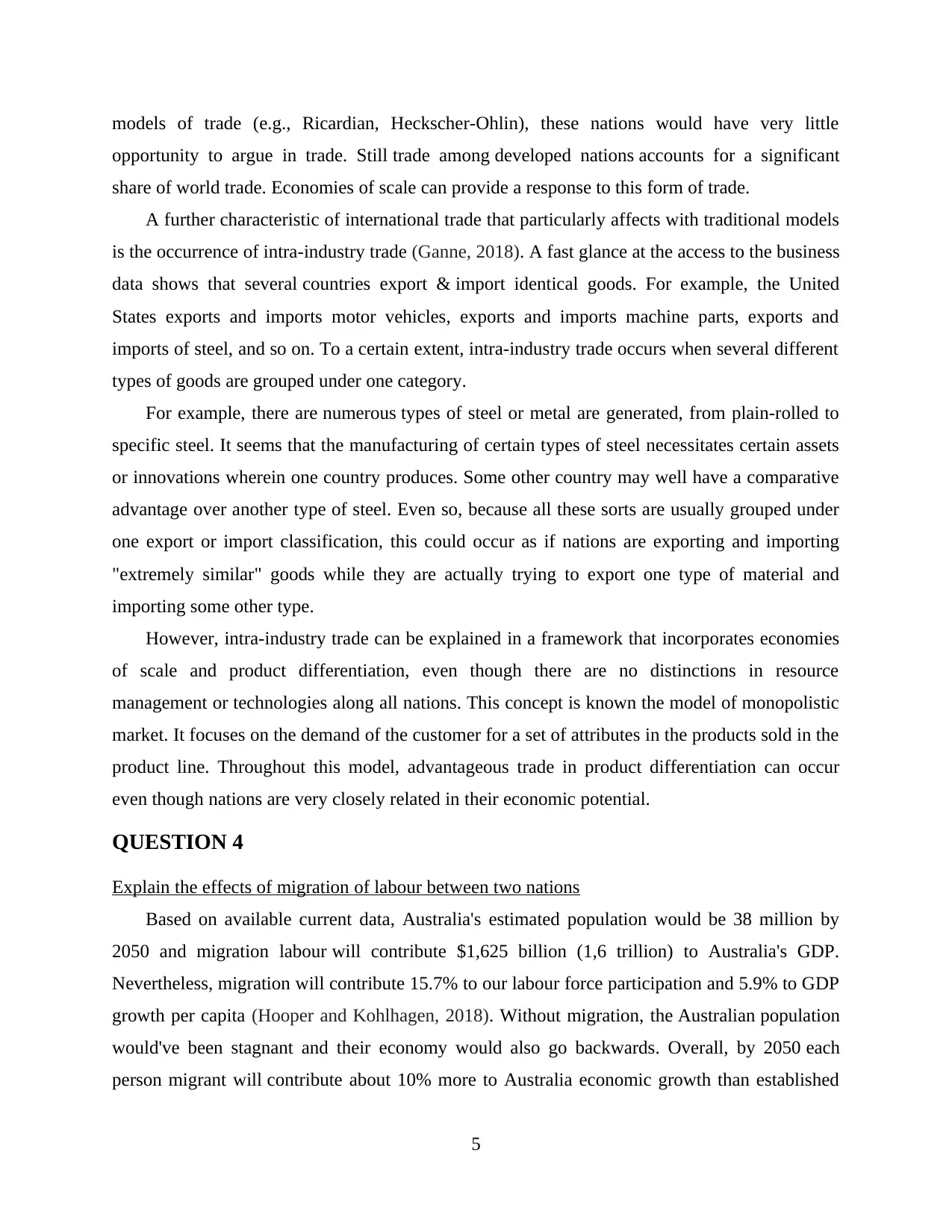
models of trade (e.g., Ricardian, Heckscher-Ohlin), these nations would have very little
opportunity to argue in trade. Still trade among developed nations accounts for a significant
share of world trade. Economies of scale can provide a response to this form of trade.
A further characteristic of international trade that particularly affects with traditional models
is the occurrence of intra-industry trade (Ganne, 2018). A fast glance at the access to the business
data shows that several countries export & import identical goods. For example, the United
States exports and imports motor vehicles, exports and imports machine parts, exports and
imports of steel, and so on. To a certain extent, intra-industry trade occurs when several different
types of goods are grouped under one category.
For example, there are numerous types of steel or metal are generated, from plain-rolled to
specific steel. It seems that the manufacturing of certain types of steel necessitates certain assets
or innovations wherein one country produces. Some other country may well have a comparative
advantage over another type of steel. Even so, because all these sorts are usually grouped under
one export or import classification, this could occur as if nations are exporting and importing
"extremely similar" goods while they are actually trying to export one type of material and
importing some other type.
However, intra-industry trade can be explained in a framework that incorporates economies
of scale and product differentiation, even though there are no distinctions in resource
management or technologies along all nations. This concept is known the model of monopolistic
market. It focuses on the demand of the customer for a set of attributes in the products sold in the
product line. Throughout this model, advantageous trade in product differentiation can occur
even though nations are very closely related in their economic potential.
QUESTION 4
Explain the effects of migration of labour between two nations
Based on available current data, Australia's estimated population would be 38 million by
2050 and migration labour will contribute $1,625 billion (1,6 trillion) to Australia's GDP.
Nevertheless, migration will contribute 15.7% to our labour force participation and 5.9% to GDP
growth per capita (Hooper and Kohlhagen, 2018). Without migration, the Australian population
would've been stagnant and their economy would also go backwards. Overall, by 2050 each
person migrant will contribute about 10% more to Australia economic growth than established
5
opportunity to argue in trade. Still trade among developed nations accounts for a significant
share of world trade. Economies of scale can provide a response to this form of trade.
A further characteristic of international trade that particularly affects with traditional models
is the occurrence of intra-industry trade (Ganne, 2018). A fast glance at the access to the business
data shows that several countries export & import identical goods. For example, the United
States exports and imports motor vehicles, exports and imports machine parts, exports and
imports of steel, and so on. To a certain extent, intra-industry trade occurs when several different
types of goods are grouped under one category.
For example, there are numerous types of steel or metal are generated, from plain-rolled to
specific steel. It seems that the manufacturing of certain types of steel necessitates certain assets
or innovations wherein one country produces. Some other country may well have a comparative
advantage over another type of steel. Even so, because all these sorts are usually grouped under
one export or import classification, this could occur as if nations are exporting and importing
"extremely similar" goods while they are actually trying to export one type of material and
importing some other type.
However, intra-industry trade can be explained in a framework that incorporates economies
of scale and product differentiation, even though there are no distinctions in resource
management or technologies along all nations. This concept is known the model of monopolistic
market. It focuses on the demand of the customer for a set of attributes in the products sold in the
product line. Throughout this model, advantageous trade in product differentiation can occur
even though nations are very closely related in their economic potential.
QUESTION 4
Explain the effects of migration of labour between two nations
Based on available current data, Australia's estimated population would be 38 million by
2050 and migration labour will contribute $1,625 billion (1,6 trillion) to Australia's GDP.
Nevertheless, migration will contribute 15.7% to our labour force participation and 5.9% to GDP
growth per capita (Hooper and Kohlhagen, 2018). Without migration, the Australian population
would've been stagnant and their economy would also go backwards. Overall, by 2050 each
person migrant will contribute about 10% more to Australia economic growth than established
5
Secure Best Marks with AI Grader
Need help grading? Try our AI Grader for instant feedback on your assignments.

residents. The economic will effect on international migration into each and every part of the
economy. It has a profoundly positive effect not only on population expansion, but also on
workforce participation and jobs, on salaries and wages, on their national skill set and on net
productivity. Too frequently, immigration is being drawn into a demographic debate where new
arrivals become the focus for many other failed policies, such as transport, infrastructure,
education, health care, etc. Migration is not taking these strategies backwards. This excludes the
positive impact, both financially and more generally, on the economy.
The economic consequences of migration differ dramatically. Going to send countries have
experienced both benefits and loss during the short period term, but may benefit over the
medium to long term (Maggi and Staiger, 2011). For recipient countries, temporary workers
schemes help to resolve skills gap, but they also reduce domestic salaries and contribute to the
burden of public welfare. The economic impact of immigration both for countries of origin and
destination may also differ depending about who is going, especially with regard to the skills of
migrant workers.
A Swedish Professor state, the issue is not immigration but the actual issue is integration,
particularly in the labour market. Since there are no employments, the results would be
segregation, housing issues and divided communities. The short-term economic gain of migrants
can be seen in remittances for exporting countries. Remittances are money that emigrants receive
from foreign countries and send to their home countries, primarily to support the family left
alone. As per the World Bank, worldwide remittances amounted to $529 billion in 2012, with
$401 billion of such money going to developing nations. Considerably, these statistics only
compensate for funds sent via structured networks, so the volume of remittances is likely much
higher than those figures indicate. The World Bank states that remittances sent via informal
networks might add at least 50% of the globally registered flows.
QUESTION 5
Infant Industry protection is a key solution for the growth of industrialization of developing
countries
The infant industry claims that developed countries are reasonable in placing tariffs on
imports as they want to grow new technology based industries and diversify their economies
(Sadeghi and Biancone, 2018). In addition, there seems to be a reason for enforcing tariffs on
6
economy. It has a profoundly positive effect not only on population expansion, but also on
workforce participation and jobs, on salaries and wages, on their national skill set and on net
productivity. Too frequently, immigration is being drawn into a demographic debate where new
arrivals become the focus for many other failed policies, such as transport, infrastructure,
education, health care, etc. Migration is not taking these strategies backwards. This excludes the
positive impact, both financially and more generally, on the economy.
The economic consequences of migration differ dramatically. Going to send countries have
experienced both benefits and loss during the short period term, but may benefit over the
medium to long term (Maggi and Staiger, 2011). For recipient countries, temporary workers
schemes help to resolve skills gap, but they also reduce domestic salaries and contribute to the
burden of public welfare. The economic impact of immigration both for countries of origin and
destination may also differ depending about who is going, especially with regard to the skills of
migrant workers.
A Swedish Professor state, the issue is not immigration but the actual issue is integration,
particularly in the labour market. Since there are no employments, the results would be
segregation, housing issues and divided communities. The short-term economic gain of migrants
can be seen in remittances for exporting countries. Remittances are money that emigrants receive
from foreign countries and send to their home countries, primarily to support the family left
alone. As per the World Bank, worldwide remittances amounted to $529 billion in 2012, with
$401 billion of such money going to developing nations. Considerably, these statistics only
compensate for funds sent via structured networks, so the volume of remittances is likely much
higher than those figures indicate. The World Bank states that remittances sent via informal
networks might add at least 50% of the globally registered flows.
QUESTION 5
Infant Industry protection is a key solution for the growth of industrialization of developing
countries
The infant industry claims that developed countries are reasonable in placing tariffs on
imports as they want to grow new technology based industries and diversify their economies
(Sadeghi and Biancone, 2018). In addition, there seems to be a reason for enforcing tariffs on
6
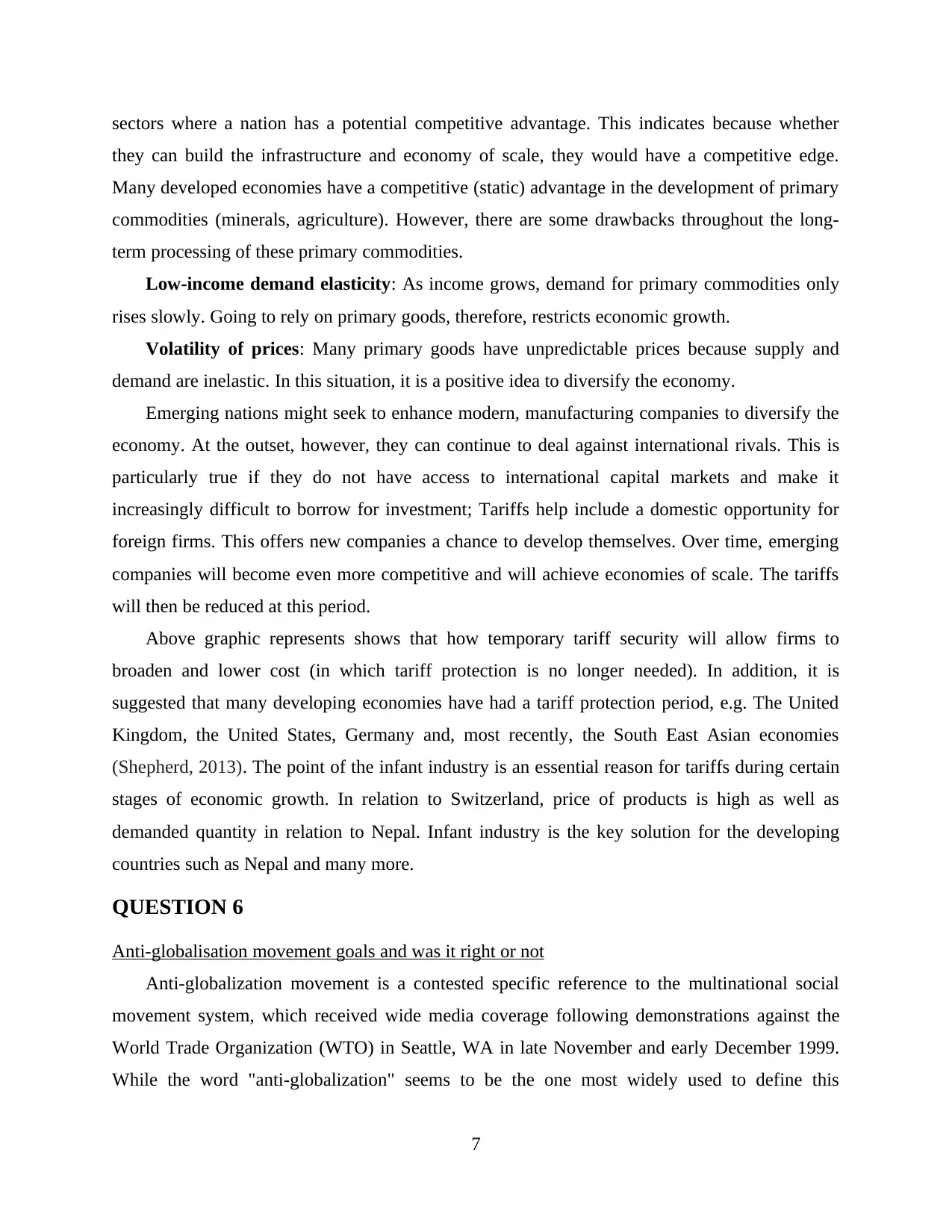
sectors where a nation has a potential competitive advantage. This indicates because whether
they can build the infrastructure and economy of scale, they would have a competitive edge.
Many developed economies have a competitive (static) advantage in the development of primary
commodities (minerals, agriculture). However, there are some drawbacks throughout the long-
term processing of these primary commodities.
Low-income demand elasticity: As income grows, demand for primary commodities only
rises slowly. Going to rely on primary goods, therefore, restricts economic growth.
Volatility of prices: Many primary goods have unpredictable prices because supply and
demand are inelastic. In this situation, it is a positive idea to diversify the economy.
Emerging nations might seek to enhance modern, manufacturing companies to diversify the
economy. At the outset, however, they can continue to deal against international rivals. This is
particularly true if they do not have access to international capital markets and make it
increasingly difficult to borrow for investment; Tariffs help include a domestic opportunity for
foreign firms. This offers new companies a chance to develop themselves. Over time, emerging
companies will become even more competitive and will achieve economies of scale. The tariffs
will then be reduced at this period.
Above graphic represents shows that how temporary tariff security will allow firms to
broaden and lower cost (in which tariff protection is no longer needed). In addition, it is
suggested that many developing economies have had a tariff protection period, e.g. The United
Kingdom, the United States, Germany and, most recently, the South East Asian economies
(Shepherd, 2013). The point of the infant industry is an essential reason for tariffs during certain
stages of economic growth. In relation to Switzerland, price of products is high as well as
demanded quantity in relation to Nepal. Infant industry is the key solution for the developing
countries such as Nepal and many more.
QUESTION 6
Anti-globalisation movement goals and was it right or not
Anti-globalization movement is a contested specific reference to the multinational social
movement system, which received wide media coverage following demonstrations against the
World Trade Organization (WTO) in Seattle, WA in late November and early December 1999.
While the word "anti-globalization" seems to be the one most widely used to define this
7
they can build the infrastructure and economy of scale, they would have a competitive edge.
Many developed economies have a competitive (static) advantage in the development of primary
commodities (minerals, agriculture). However, there are some drawbacks throughout the long-
term processing of these primary commodities.
Low-income demand elasticity: As income grows, demand for primary commodities only
rises slowly. Going to rely on primary goods, therefore, restricts economic growth.
Volatility of prices: Many primary goods have unpredictable prices because supply and
demand are inelastic. In this situation, it is a positive idea to diversify the economy.
Emerging nations might seek to enhance modern, manufacturing companies to diversify the
economy. At the outset, however, they can continue to deal against international rivals. This is
particularly true if they do not have access to international capital markets and make it
increasingly difficult to borrow for investment; Tariffs help include a domestic opportunity for
foreign firms. This offers new companies a chance to develop themselves. Over time, emerging
companies will become even more competitive and will achieve economies of scale. The tariffs
will then be reduced at this period.
Above graphic represents shows that how temporary tariff security will allow firms to
broaden and lower cost (in which tariff protection is no longer needed). In addition, it is
suggested that many developing economies have had a tariff protection period, e.g. The United
Kingdom, the United States, Germany and, most recently, the South East Asian economies
(Shepherd, 2013). The point of the infant industry is an essential reason for tariffs during certain
stages of economic growth. In relation to Switzerland, price of products is high as well as
demanded quantity in relation to Nepal. Infant industry is the key solution for the developing
countries such as Nepal and many more.
QUESTION 6
Anti-globalisation movement goals and was it right or not
Anti-globalization movement is a contested specific reference to the multinational social
movement system, which received wide media coverage following demonstrations against the
World Trade Organization (WTO) in Seattle, WA in late November and early December 1999.
While the word "anti-globalization" seems to be the one most widely used to define this
7

campaign, many have referred to the inconsistency of this title. The anti-globalization campaign
doesn't really respond to the concept of globalisation, but to the manner it has evolved. Anti-
globalization protesters note that current globalisation policies have resulting in unequal and
devastating circumstances in many nations.
Most of the economic experts said that, goals of anti-globalization movement are right
because it helps in minimising the risk of poverty due to globalization (Van Bergeijk and
Brakman, 2010). They argue that multinational corporations have risen in intensity, influence,
and resources, while developing countries are still struggling with deep poverty. They pointed
out that globalisation has led many companies to employ low-wage workers in underdeveloped
nations, taking away jobs from people in the developing world. Environmental security also has
been lost, according to critics, in the name of globalisation. Large companies have avoided
tighter environmental controls in developed nations by moving factories towards less-regulated
countries. Many critics also contend that, in contrast to selling goods to other countries,
dominant Western nations have indeed exported their traditions, placed their practices on
faraway places, and eradicated local cultures, languages, and practises.
CONCLUSION
From the above discussion it was concluded that, international trade is not just the exchange
of goods and services, and that it also allows nations to build an empire that is also advantageous
to both individuals and industries. Global trade is perceived to reduce real income in some
sectors leading to a decrease in wages for a part of the population. However, cheaper imports
may also lower local costs for consumers, and the impact of this influence might be greater than
any potential effect of wages. Any trade policy linked to certain favourable and unfavourable
aspects that affect the economy or give rise to such disputes.
8
doesn't really respond to the concept of globalisation, but to the manner it has evolved. Anti-
globalization protesters note that current globalisation policies have resulting in unequal and
devastating circumstances in many nations.
Most of the economic experts said that, goals of anti-globalization movement are right
because it helps in minimising the risk of poverty due to globalization (Van Bergeijk and
Brakman, 2010). They argue that multinational corporations have risen in intensity, influence,
and resources, while developing countries are still struggling with deep poverty. They pointed
out that globalisation has led many companies to employ low-wage workers in underdeveloped
nations, taking away jobs from people in the developing world. Environmental security also has
been lost, according to critics, in the name of globalisation. Large companies have avoided
tighter environmental controls in developed nations by moving factories towards less-regulated
countries. Many critics also contend that, in contrast to selling goods to other countries,
dominant Western nations have indeed exported their traditions, placed their practices on
faraway places, and eradicated local cultures, languages, and practises.
CONCLUSION
From the above discussion it was concluded that, international trade is not just the exchange
of goods and services, and that it also allows nations to build an empire that is also advantageous
to both individuals and industries. Global trade is perceived to reduce real income in some
sectors leading to a decrease in wages for a part of the population. However, cheaper imports
may also lower local costs for consumers, and the impact of this influence might be greater than
any potential effect of wages. Any trade policy linked to certain favourable and unfavourable
aspects that affect the economy or give rise to such disputes.
8
Paraphrase This Document
Need a fresh take? Get an instant paraphrase of this document with our AI Paraphraser
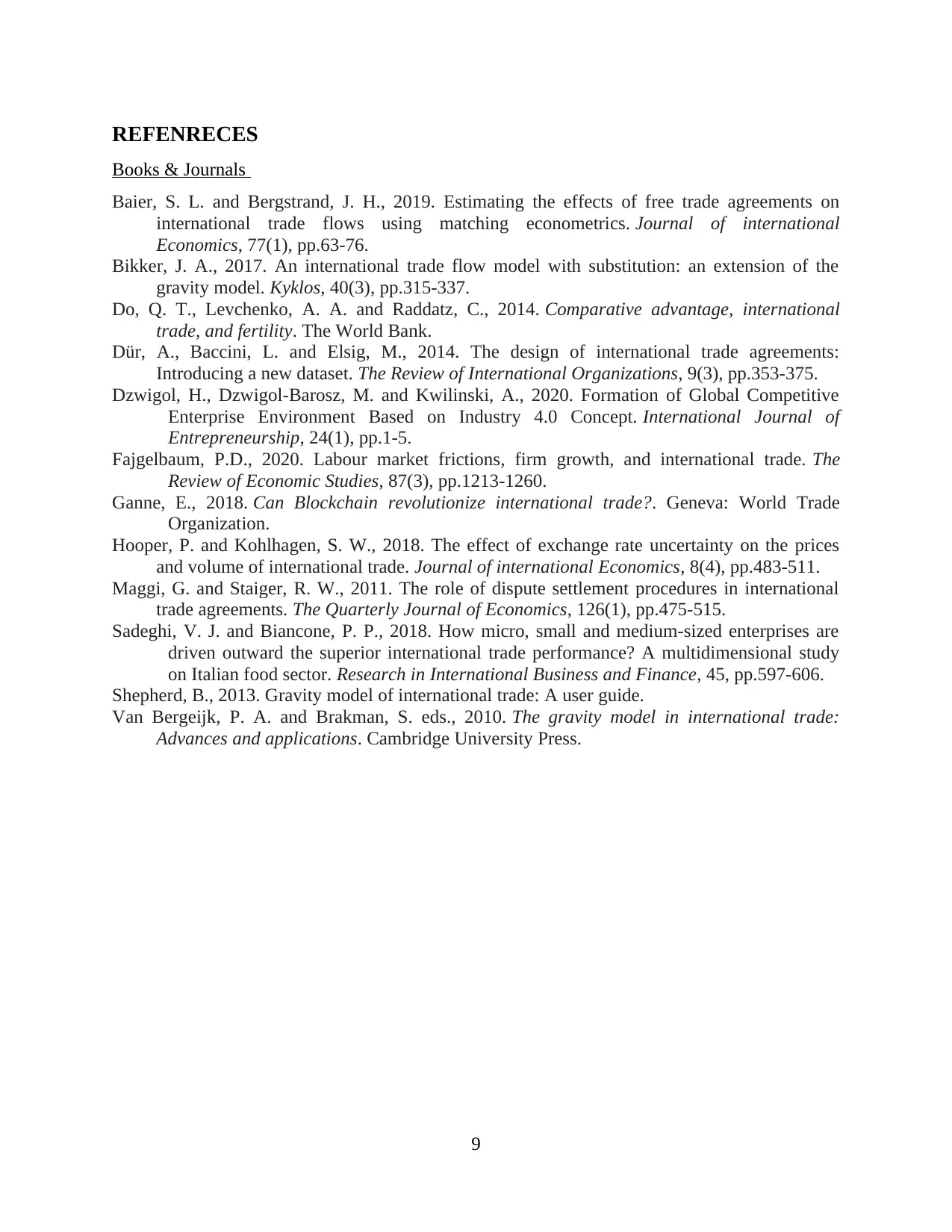
REFENRECES
Books & Journals
Baier, S. L. and Bergstrand, J. H., 2019. Estimating the effects of free trade agreements on
international trade flows using matching econometrics. Journal of international
Economics, 77(1), pp.63-76.
Bikker, J. A., 2017. An international trade flow model with substitution: an extension of the
gravity model. Kyklos, 40(3), pp.315-337.
Do, Q. T., Levchenko, A. A. and Raddatz, C., 2014. Comparative advantage, international
trade, and fertility. The World Bank.
Dür, A., Baccini, L. and Elsig, M., 2014. The design of international trade agreements:
Introducing a new dataset. The Review of International Organizations, 9(3), pp.353-375.
Dzwigol, H., Dzwigol-Barosz, M. and Kwilinski, A., 2020. Formation of Global Competitive
Enterprise Environment Based on Industry 4.0 Concept. International Journal of
Entrepreneurship, 24(1), pp.1-5.
Fajgelbaum, P.D., 2020. Labour market frictions, firm growth, and international trade. The
Review of Economic Studies, 87(3), pp.1213-1260.
Ganne, E., 2018. Can Blockchain revolutionize international trade?. Geneva: World Trade
Organization.
Hooper, P. and Kohlhagen, S. W., 2018. The effect of exchange rate uncertainty on the prices
and volume of international trade. Journal of international Economics, 8(4), pp.483-511.
Maggi, G. and Staiger, R. W., 2011. The role of dispute settlement procedures in international
trade agreements. The Quarterly Journal of Economics, 126(1), pp.475-515.
Sadeghi, V. J. and Biancone, P. P., 2018. How micro, small and medium-sized enterprises are
driven outward the superior international trade performance? A multidimensional study
on Italian food sector. Research in International Business and Finance, 45, pp.597-606.
Shepherd, B., 2013. Gravity model of international trade: A user guide.
Van Bergeijk, P. A. and Brakman, S. eds., 2010. The gravity model in international trade:
Advances and applications. Cambridge University Press.
9
Books & Journals
Baier, S. L. and Bergstrand, J. H., 2019. Estimating the effects of free trade agreements on
international trade flows using matching econometrics. Journal of international
Economics, 77(1), pp.63-76.
Bikker, J. A., 2017. An international trade flow model with substitution: an extension of the
gravity model. Kyklos, 40(3), pp.315-337.
Do, Q. T., Levchenko, A. A. and Raddatz, C., 2014. Comparative advantage, international
trade, and fertility. The World Bank.
Dür, A., Baccini, L. and Elsig, M., 2014. The design of international trade agreements:
Introducing a new dataset. The Review of International Organizations, 9(3), pp.353-375.
Dzwigol, H., Dzwigol-Barosz, M. and Kwilinski, A., 2020. Formation of Global Competitive
Enterprise Environment Based on Industry 4.0 Concept. International Journal of
Entrepreneurship, 24(1), pp.1-5.
Fajgelbaum, P.D., 2020. Labour market frictions, firm growth, and international trade. The
Review of Economic Studies, 87(3), pp.1213-1260.
Ganne, E., 2018. Can Blockchain revolutionize international trade?. Geneva: World Trade
Organization.
Hooper, P. and Kohlhagen, S. W., 2018. The effect of exchange rate uncertainty on the prices
and volume of international trade. Journal of international Economics, 8(4), pp.483-511.
Maggi, G. and Staiger, R. W., 2011. The role of dispute settlement procedures in international
trade agreements. The Quarterly Journal of Economics, 126(1), pp.475-515.
Sadeghi, V. J. and Biancone, P. P., 2018. How micro, small and medium-sized enterprises are
driven outward the superior international trade performance? A multidimensional study
on Italian food sector. Research in International Business and Finance, 45, pp.597-606.
Shepherd, B., 2013. Gravity model of international trade: A user guide.
Van Bergeijk, P. A. and Brakman, S. eds., 2010. The gravity model in international trade:
Advances and applications. Cambridge University Press.
9
1 out of 11
![[object Object]](/_next/static/media/star-bottom.7253800d.svg)




